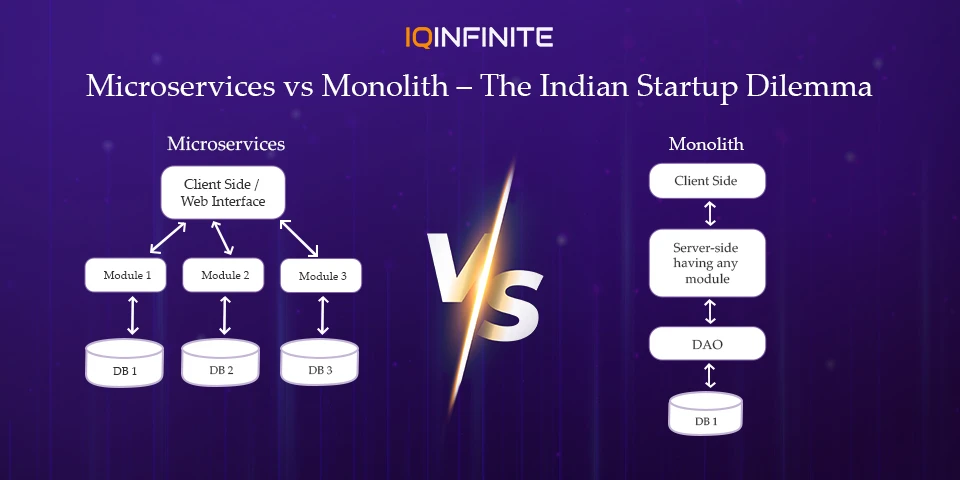Microservices vs Monolith: Which Architecture Fits Indian Startups Best?

When building a startup, especially in India’s hyper-competitive market, every decision counts. Among the most critical is choosing the right software architecture the very foundation on which your product will scale, pivot or even fail.
For Indian founders, this choice becomes even more strategic. Budgets are tight, engineering teams are lean and speed-to-market often determines survival. A wrong call early on can slow you down, increase costs and limit scalability just when your product starts to gain traction.
Two dominant approaches shape this decision:
• Monolithic Architecture - A single, unified codebase where all features and modules are tightly coupled.
• Microservices Architecture - A distributed model where applications are broken into independent, modular services connected via APIs.
Many Indian startups, especially those building desktop or hybrid applications, often rely on familiar platforms like Windows 10 for development, testing and deployment. Choosing an architecture that aligns with your existing environment including operating systems, developer tools and cloud integrations.
What is Monolithic Architecture?
Think of it as one big box: everything sits inside, tightly connected.
Advantages of Monoliths for Startups
Speed is everything in the early days. A monolith allows you to quickly prototype, launch and iterate without worrying about distributed systems.
• Example: An edtech startup can bundle courses, quizzes and payments into one application and hit the market fast.
2. Lower Initial Costs
• Simpler infrastructure: one server, one codebase, one deployment pipeline.
• No need for costly DevOps setups, containerization or orchestration tools in the beginning.
3. Easy Deployment & Debugging
Since everything is in one place, bug tracking and releasing new features are straightforward.
4. Perfect for Small Teams
When you only have a handful of developers, it’s easier to manage a single codebase.
Disadvantages of Monoliths
If one part (like payments) needs more resources, you still must scale the entire app.
2. Code Complexity Over Time
As features pile up, the codebase can become a tangled mess what developers call “spaghetti code.”
3. Technology Lock-In
Adopting a new language or framework is tough since everything depends on a single stack.
4. Slower Collaboration for Large Teams
With more engineers, conflicts arise because everyone is working on the same codebase.
Best Fit: Early-stage Indian startups validating ideas or building an MVP with a small team.
What is Microservices Architecture?
For example:
• User Service → Handles authentication and profiles
• Payment Service → Processes transactions
• Recommendation Service → Suggests products or content
These services communicate via APIs or messaging systems.
Think of it as a city where each building has a unique role but they work together to serve the people.
Advantages of Microservices for Startups
Only scale the part that needs more resources.
• Example: If payments traffic spikes, you scale just the payment service, not the whole app.
2. Tech Stack Flexibility
Different services can use different tools.
• Example: Node.js for the user service, Python for machine learning recommendations.
3. Built-In Resilience
If one service (say notifications) fails, the rest of the application still works.
4. Faster Parallel Development
Large teams can build different services independently without stepping on each other’s code.
5. Easier Long-Term Maintenance
Smaller, focused services are simpler to update and refactor.
Disadvantages of Microservices
You need CI/CD pipelines, API gateways, monitoring orchestration tools (Docker, Kubernetes) all of which take time and expertise.
2. Higher Costs
Running multiple services means more servers, containers and cloud expenses.
3. Steeper Learning Curve
Your team must have strong DevOps and cloud skills to manage distributed systems.
4. Debugging Challenges
Tracing issues across multiple logs and services is much harder than in a monolith.
Best Fit: Startups with proven product-market fit, a growing user base and larger engineering teams.
Monolith First, Microservices Later: A Balanced Playbook
Start with a Monolith
• Keep costs lean: You don’t need expensive cloud setups, container orchestration or a big DevOps team.
• Focus on learning: Early days are all about validating your idea, listening to users and iterating not managing distributed systems.
Modularize the Monolith
• Futureproofing: This discipline ensures that when the time comes, you can peel off these modules into microservices without a painful rewrite.
Transition Gradually to Microservices
• Reduce risk: Don’t break everything apart at once. A step-by-step migration keeps your system stable while unlocking scalability and flexibility.
Conclusion
- Early-Stage Startups (Validation Phase): Monolithic architecture is your best ally simple, cost-effective and fast to build.
- Growth & Scaling Stage: As traffic, users and team size grow, microservices become essential for resilience, flexibility and speed at scale.
By starting simple, planning modularly and transitioning at the right time, Indian startups can avoid costly rebuilds while setting themselves up for long-term growth.
